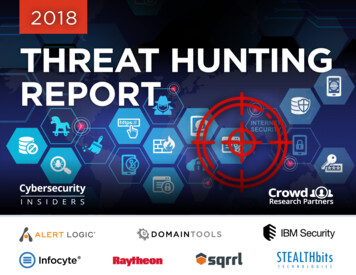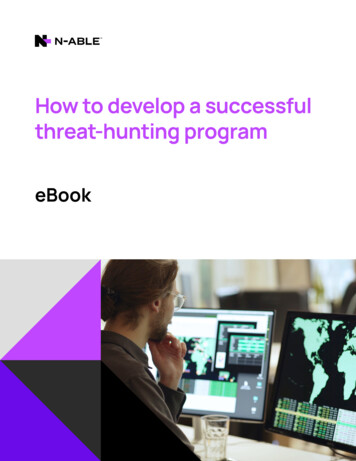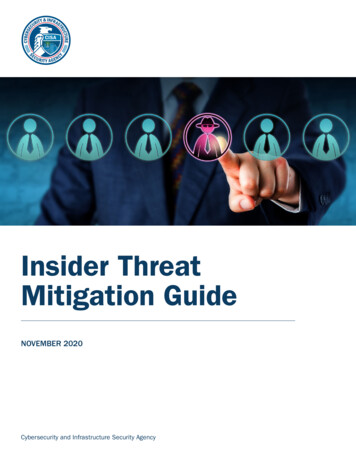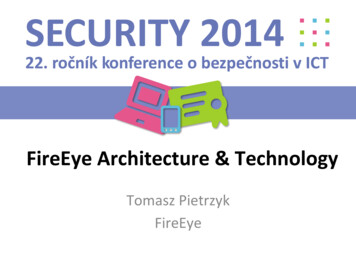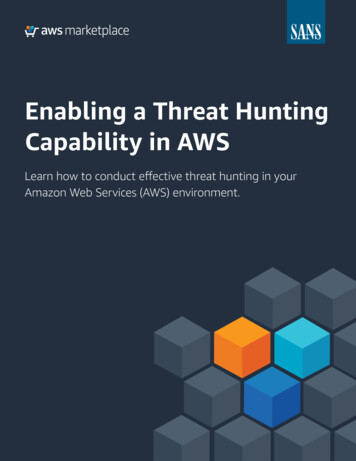
Transcription
Enabling a Threat HuntingCapability in AWSLearn how to conduct effective threat hunting in yourAmazon Web Services (AWS) environment.
AWS Marketplace IntroductionThreat hunting offers proactive ways to detect anomalous behavior in your environment, but it is a journey with manyconsiderations to make along the way. In this whitepaper, SANS analyst, Shaun McCullough walks through the threathunting process and how it should fit into an organization’s overall security strategy. He also discusses what data togather, options for analyzing it, and the kinds of tools threat hunters can use in their cloud environment.Building on McCullough’s perspective, AWS Marketplace will share how you can begin this process to your AWSenvironment. They will provide an introduction to relevant software seller solutions that can enable your threat huntingjourney through efficiencies and enhancements. Finally, Sumo Logic will be featured as an available option that canfacilitate your threat hunting program.The featured Sumo Logic solution for this use case can be leveraged in AWS Marketplace:Sumo Logic Cloud-Native MachineData Analytics Service (Annually)Continuous intelligence across yourentire application lifecycle and stack
A SANS WhitepaperHow to Build a Threat Hunting Capability in AWSWritten by Shaun McCulloughSponsored by:November 2019AWS MarketplaceIntroductionThe infrastructure is built, a patching plan is in place, firewalls are locked down andmonitored, assets are managed, and the SOC team is responding to alerts from thesecurity sensors. When basic security hygiene is implemented, the threat hunting teamneeds to start evaluating infrastructure for any threats and undetected breaches.Because infrastructures are complex, with many moving parts, teams need a plan tomanage all the data from all the various operating systems, networking tools andcustom applications. They also need to know which threats to look for, how to prioritizethem and where to start hunting.Cloud environments bring their own set of complexity and peculiarities for threathunting. Customers realizing the benefits of elastic environments may find that systemsthat had a threat on Friday are terminated on Sunday. Reliance on cloud services likelymeans relying on the data they offer in a platform-specific format. In addition to thecloud, the management plane is now a new threat vector that teams have to consider,along with web apps, virtual machines and databases.Threat huntingThe proactive evaluation ofthe infrastructure operationsto detect a threat beyond thedeployed security toolsIn this paper, we walk through the threat hunting process and how it should fit intoan organization’s overall security strategy. We discuss how to determine what data togather, options for analyzing it and the kinds of tools threat hunters can use in cloudenvironments. 2019 SANS Institute
Threat Hunting on Premises vs. in the CloudIt is vital to understand the process of threat hunting and how to approach it differentlythan standard security operations. Let’s look at this process in the context of a webapplication. To enhance understanding, this paper references a common use case foundin cloud architecture: managing a web application.Web Application Use CaseA database-based web application is running and is internet-facing. The virtual machine(VM) is running a critical business application and would be considered a potentialtarget. Although the methods of attack against web applications in the cloud are similarto those on premises, threat huntersmust adjust their approach and adopta new set of tools for detection andAWSCloudRegionremediation.The cloud management plane is anattack vector that threat hunters mustAWS GeneralInternet GatewayVirtualPrivate Cloudevaluate. If attackers were to gain aAvailabilityZonefoothold in a web application, couldthey leverage it to get further into thecloud infrastructure? Could they makeWeb ServerPublic Subnetchanges, set up persistence and spinup a cryptocurrency mining rig thatDatabasePrivate Subnetwill run at great expense to the victim?The damage can be financially andlegally impactful. The web application isAmazon S3 Bucketwith Config Filesrunning on an Amazon Elastic ComputeCloud (EC2),1 a VM, that reaches out toan Amazon S3 bucket to retrieve configuration files every time the server starts up. ThisFigure 1. Web Application Use Caseuse case, illustrated in Figure 1, is simplified by design to help tell the threat huntingstory. A properly architected web application would include additional protections.How to Approach Threat HuntingThreat hunting is more of an art than a science, in that its approach andimplementation can differ substantially among various organizations and stillbe right. Every organization builds and operates its infrastructure in its own way;their teams have varied compositions of skill sets, talents and goals, and they facedifferent threat risks.1 his paper mentions product names to provide real-life examples of how threat hunting tools can be used. The use of these examples is not anTendorsement of any product.How to Build a Threat Hunting Capability in AWS2
Threat hunting is about approaching security from adifferent angle. For instance, the security operationscenter (SOC) has a collection of alerts from varioussecurity products, such as antivirus scans, emailsecurity solutions, vulnerability scans, firewallCIS Critical Controls Are Vital to Threat HuntingThe Center for Internet Security (CIS) identifies 20 essential securitycontrols, the first six of which are basic controls. Table 1 lists thesebasics controls and describes their importance to creating an effectivethreat hunting program.alerts, IDS/IPS, and login failures. If a scan showsthat a production server is vulnerable with a criticalalert, a SOC member creates a ticket for the serveradministration teams to plan for an update. The driverof that interaction is a security product alerting on astrong indicator. Thus a workload needs to be patched.Threat hunting starts with the premise of, “Our mainweb application is facing the internet and may be thevictim of a web attack. Let’s see how we can determinethat.” Or maybe a weak indicator sparks suspicion:“Multiple failed SQL injection attacks in a row. The webserver performance is slower. Let’s look for potentialintrusions.” There are multiple scenarios in betweenthat can all be considered threat hunting.With a strong indicator from a security service, thereTable 1. CIS Critical Controls and Threat Hunting2CIS ControlDescriptionControl 1: Inventory andControl of Hardware AssetsThreat hunters need to know andmanage hardware and software assets,so they can identify which infrastructureservices to evaluate and what software isapproved.Control 2: Inventory andControl of Software AssetsControl 3: ContinuousVulnerability ManagementControl 5: SecureConfiguration for Hardwareand Software on MobileDevices, Laptops,Workstations and ServersBy eliminating software vulnerabilities,threat hunters can save time andresources.Control 4: Controlled Use ofAdministrative PrivilegesOrganizations should limit the use ofadmin privileges so threat hunters canbetter determine what is legitimate use.Control 6: Maintenance,Monitoring and Analysis ofAudit LogsThe core of threat hunting relies onproper managing, monitoring andanalysis of logs.is a process in place to remedy the situation. Withthreat hunting, the team is looking for anomalous behaviors without strong indicators.The outcome is likely unknown, the investigation is murky, and the process is researchintensive. It is essential to build a threat hunting process and environment to maximizethe effectiveness of the team.Threat Hunting LoopCREATEHypothesisBuilding a threat hunting process from scratch takes time, resources andthe ability to reach out to experts inside and outside the organization.The Threat Hunting Loop,3 shown in Figure 2, describes the process fordetermining what threat to hunt for, evaluating it and then automatingthe further investigation.INFORMINVESTIGATEand Enrichwith Analyticsvia Tools andTechniquesThe threat hunting process is all about deciding what potential threatactivity to look for, using tools to analyze the available data and teasingout patterns that could indicate a likely event. Each of these steps of theloop is unique to your organization, its infrastructure, the data availableUNCOVERNew Patternsand TTPsto the team and the tools at its disposal.Figure 2. Threat Hunting /3www.threathunting.net/sqrrl-archiveHow to Build a Threat Hunting Capability in AWS3
Create HypothesisStep one is to create the hypothesis. Did the attacker gain a foothold in the productionweb application? Could credentials be accidentally embedded in the packaged software?Is there an unknown, CPU-intensive process running on an important server? The sheerscope of potential hypotheses could grind any team progress to a halt.Identifying and prioritizing the most at-risk infrastructure components requires anunderstanding of which systems are most vulnerable and their values to the business.4By starting with a threat modeling process, an organization has an outline of prioritysystems that have a risk and are vulnerable to some set of attacks.The threat hunting team needs to build a set of techniques to investigate and create ahypothesis of how those attacks would work and what artifacts are in the logs that needto be analyzed. Organizations with an offense-focused team, like a pen-test group or redteam, have in-house experts who research and practice attacker techniques.At-risk infrastructure has oneof four possible responses:attempt to mitigate the threat,eliminate the threat throughinfrastructure architecture,transfer the risk to a third partyor just accept the risk.Others may need to rely on researching published materials on attack techniques tocreate new hypotheses. For example, the MITRE ATT&CK Framework is growing inpopularity among researchers and security companies (see Figure 3). Although notcloud-specific, the ATT&CK Framework provides a detailed explanation of the hows andwhys of specific attacker techniques.MITRE Enterprise ATTACK FrameworkSpecifically, the technique of gaining initial access by exploiting public-facing appsFigure 3. MITRE ATT&CKFramework5is relevant to the web app use case. ATT&CK describes the purpose of the technique,the types of platforms, potential mitigations and references to online reports. Theinformation provided on this technique does not give us enough details to start hunting,4 Learn more about the threat modeling process in “How to Protect a Modern Web Application in st/protect-modern-web-application-aws-38955, [Registration required.]5 https://attack.mitre.org/How to Build a Threat Hunting Capability in AWS4
but it does point to the OpenWeb Application Security Project(OWASP) Top 10, which is morerelevant to the use case. Moredetail is noted in Figure 4.When identifying the potentialattacks against a webapplication, one of the bestsources is the OWASP Top 10. TheOWASP Top 10 is a documentedexplanation of the top securitythreats to web applications,detailing the attacker techniques,examples and potential ways tomitigate.The top threat in the OWASPTop 10 is an injection attack, orgetting untrusted data sent tothe interpreter and executedas part of a command or query.Figure 4. The Exploit Public-Facing Application Technique6(See Figure 5.) In a SQL injectionattack on a web server, theattacker provides unexpectedvalues for the usernameor password to thwart theinterpreter from retrieving theexpected SQL values.The Cloud Security AllianceFigure 5. Number One Threat in the OWASP Top 107(CSA) publishes a report ontop threats8 that focuses specifically on cloudservices. The CSA also publishes an in-depth casestudy that walks through how those threats are9carried out. Rhino Security is a pen-test company,but it publishes blogs and free tooling for cloudand containerization threats.Other publications and researchers who track anddescribe attacker techniques include: Threat Post Threat Hunting Project AWS Security Bulletin (ISC)2 Cloud Security Report Summit Route Toni de la Fuente’s running list of AWS Security Tools6 “Exploit Public-Facing Application,” https://attack.mitre.org/techniques/T1190/7 OWASP Top Ten Project, www.owasp.org/index.php/Category:OWASP Top Ten Project8 loud Security Alliance, Top Threats to Cloud Computing: Egregious 9 loud Security Alliance, Top Threats to Cloud Computing: Deep top-threats-to-cloud-computing-deep-dive/How to Build a Threat Hunting Capability in AWS5
Investigate Via Tools and TechniquesThreat hunters go beyond the automated alerts from security products, past the strongindicators and into the squishy unknown. To do this, data must be collected, understood,analyzed and viewed comprehensively. Threat hunters must also pivot through differenttypes of logs and explore unstructured or partially structured data.The first hurdle can be the infrastructure itself. If the organization has dozens of uniqueoperating system configurations, manually managed deployment or shared remotemanagement, then logs and operational data will be highly variant, allowing real attacksto blend in. Let’s look at another use case.Use Case: GatheringSSH ConnectionsLeveraging infrastructureAlarmas code, it is possibleto deploy productionsystems withoutWebServeradministrators SSH’ing,except in cases ofAmazonCloudWatchAgentLogGrouptroubleshooting. TeamsMetricAmazonCloudWatchDashboardcan easily pull logs fromany system and intoAmazon CloudWatch. SeeFigure 6. Overview of AmazonCloudWatch Log CollectionFigure 6.To use the Amazon CloudWatch agent to pull SSH connection logs from Amazon EC2sand into the Amazon CloudWatch logging service, follow these steps:1.Install the Amazon CloudWatch agent on an EC2.2. Configure the Amazon CloudWatch agent to send SSH connections to a specificlog group.3. Set up Amazon CloudWatch alarms to monitor for invalid user attempts andrepeated SSH disconnects.The Ever-Changing Cloud InfrastructureCloud service elasticity can make it difficult to directly interrogate systems when theenvironment is continually growing and shrinking throughout a day. For example, let’ssay the web application is attacked at 10 p.m. with a SQL injection attack that triggerslogs from the web application firewall (WAF). The next day at 9 a.m., the threat huntingteam investigates to determine if the attack was successful. Unfortunately, the VM hasalready been terminated by the cloud autoscaling engine. The threat hunting teamneeds to decide what data to collect from the elastic system, whether that data isreadily available or needs to be pulled or pushed by additional systems, and how longto keep the data before aging it off. The threat hunter needs to account for the risk ofthose systems, the amount of data that might need to be stored and how quickly a teamwill evaluate the data. The following demonstrates an example.How to Build a Threat Hunting Capability in AWS6
Use Case: Post-Exploitation DetectionIn a cloud environment of automation, once attackers gain access to the webapplication VM, they will want to use the MITRE ATT&CK tactic called Discover to findother services of interest, such as an accessible Amazon S3 bucket with the commandListBuckets. The web application we built has access to Amazon S3 buckets forconfiguration, but the IAMrole does not allow listingof buckets. Automatedsystems likely alreadyknow the resources theyneed to interact with, so listing potential names is unnecessary. From the Amazon EC2Figure 7. A ListBuckets Errorinstance, listing buckets results in an error, as shown in Figure 7.AWS CloudTrail gathersand allows an analysisof Amazon Web Services(AWS) API requests. AWSCloudTrail, using theAmazon EC2 ID as theusername, looks at theListBuckets as anindicator. There is anAccessDenied errorcode, as shown in Figure 8.Figure 8. AccessDenied ErrorCodeAnother option is to use the AWS Command Line Interface (CLI) to look for all commandsfrom the Amazon EC2 in question:aws cloudtrail lookup-events --lookup-attributesAttributeKey Username, AttributeValue i-0b1515ec2d4b0b9df es[0].ResourceName)}' --output table -region us-east-1Figure 9 shows sampleresults of AWS CloudTraillookup-events.Figure 9. Table Output of AWS CloudTraillookup-events CommandHow to Build a Threat Hunting Capability in AWS7
Each event has a uniqueevent ID. Figure 10shows the details for aspecific event ID fromthe table shown in Figure9. Here, we use a Linuxapplication, JQ, to carve up JSON on the command line.This command shows the details of this particular AWS CloudTrail Event. JQ is anFigure 10. JSON Output of AWSCloudTrail lookup-eventsexcellent tool for filtering, carving and formatting the JSON data in logs.Uncover New Patterns and Apply Learned LessonsGathering data, running analytics and identifying the anomalies give the threathunter unique insights into evaluating attack techniques and analyzing infrastructuresystems. The team should become part of the threat modeling processes, helpingthe architecture and operations teams identify the cloud infrastructure that needsto be secured and evaluated. Changes such as improved monitoring, reduced chaoticdeployments and better segmentation of infrastructure can all make threat huntingeasier without losing operational capabilities.Once threat hunters understand the challenges, they can start gathering detailedknowledge of potential threats, and the architecture and infrastructure managementteams can support the threat hunters. It is time to begin collecting and analyzing thedata needed to discover the attackers.Inform with Data and AnalyticsIt is critical to get the right data into the right place for analysis. The data itself mightneed to be evaluated, enriched and prepared for analysis using scripts, tools or built-incloud services.Gathering the DataThe threat hunting team has to strike the right balance of how much data to capture.Requiring all the data from all the things increases costs, adds to the overhead ofmanaging the data and increases the time and effort to sift through and analyze theenormous amounts of data. On the other hand, not having enough data will keep thethreat hunters in the dark. First, identify any logs that are already being collected orare easy to obtain organically. AWS makes it easy to collect VPC logs showing dataconnections in and out of the VPC, API calls with AWS CloudTrail and Amazon S3 accesslogs, among others.Then, using the attacker techniques, the team will focus on identifying the gaps ininformation and how to retrieve it. Most missing data is likely from applications or thehost environment itself. Let’s revisit the web application use case.How to Build a Threat Hunting Capability in AWS8
Web Application Use CaseFor the web application use case, the VM itself has a wealth of information that couldbe of interest. Mainstream web servers generate standard logs that are stored on theVM. They also can be customized to generate more or fewer logs, orwith changes to the format or location, and potentially compressed fortransfer. Connection logs, for example, contain every HTTP request tothe web server. Regularly managed web applications have a lot of thesame connections. However, in a path traversal attack,10 the path couldcontain unique path calls that are attempts to get access to files onthe web server.After installing the Amazon CloudWatch agent, configure the AmazonCloudWatch configuration file to pull the Nginx access logFigure 11. Amazon CloudWatch LogsConfiguration File/var/log/nginx/access.log. See Figure 11.The Nginx connection logsare now stored in the /var/log/nginx loggroup, accessible fromAmazon CloudWatch Logs.See Figure 12.Opening up the log group,it’s possible to search for a string, as shown in Figure 13.This is an easy search. AWS provides an advanced query service called AmazonFigure 12. Nginx Connection LogsFigure 13. Quick Search for passwdCloudWatch Logs Insights. Using a custom query language, we can search across allhosts for a regex of passwd, etc or ./ as shown in Figure 14. Notethat / is a special character in regular expression (regex), so it has tobe escaped with \.Figure 14. Query AmazonCloudWatch Logs Insights10 www.owasp.org/index.php/Path TraversalHow to Build a Threat Hunting Capability in AWS9
Figure 15 shows theresults of the query.Once the data is gathered,the data retention lifecycle rule is applied anddata is accessible, it’s timeto figure out how to makethe data more useful tothe threat hunters byenriching the data.Enriching the DataWhen threat hunting,the data needs to tell acomplex and completestory with multiplecharacters, settings andsubplots. If a single logcould tell the story, then a security product would quickly alert the SOC. Threat huntersFigure 15. Query Resultsare looking for more subtle anomalies in the data that look unique mainly because ofthe way an infrastructure is architected and operated. An attachment in the email iseasily scanned and compared to a known list of malware. However, it’s harder to identifySeparate Security Accounta nefarious remote desktop connection compared to a legitimate one. One easy wayIt is good to gather and protectany logs from accidental orpurposeful deletion. Onerecommendation is to useAWS Organizations to create aseparate security organization(org) and to automatically movelogs from the production org tothe security org, where it can beprotected and available to onlythe security or designated teams.to bring data to life is to automatically evaluate the data and tag it, add metadata orenhance the data itself.Web Application Use CaseThere are several ways to automate the analysis and tagging or enriching the data. Forlogs collected by Amazon CloudWatch, such as Nginx connection logs, leveraging thealarms, metrics and dashboards works well. An Amazon CloudWatch Metric Filter willsearch for some specific patterns and create a metric count when that pattern showsup in the logs. An Amazon CloudWatch metric can generate an alarm, which can sendan email or notify an AWS Lambda function. The AWS Lambda function can take action,such as copying the concerning data over to an Amazon S3 bucket for further analysis.In the Amazon EC2 Role use case, the victim EC2 can perform S3 bucket reads. Let’ssay there are 50 EC2 instances in the account; that would be too much data to analyze.However, if the EC2 reads a different S3 bucket than it has ever read before, that is a newactivity. You should tag those reads.Analyzing the DataOnce the data has been gathered, enriched and tagged, the threat hunting team startsevaluating the data to identify anomalous behaviors against the hypothetical attacktechniques. The threat hunting team must be able to evaluate anomalies and quicklydetermine if they warrant an investigation or not, so the data must be easy to search,How to Build a Threat Hunting Capability in AWS10
correlate and report. Various scripting tools and analytic platforms can provide threathunters with raw log data to sift through. Comprehensive analytic platforms can alsobe utilized to help speed up analysis, and provide reporting services for sharing andcollaboration among teams.The next sections dive into options for analytic tools to bring into the environment totake threat hunting to the next level.Tools for AnalysisThreat hunters can bring a wide range of tools to bear to analyze complex datasets frommultiple sources, from scripts parsing raw data, to a full SIEM system that provides adhoc and complex searching, reporting and investigations. The decision is usually aboutsetup complexity, cost andthe need to scale as theteam grows. AWS providesseveral services that canbe used and chainedtogether to scripts andanalytics.Analyzing LogsDirectlyAmazon CloudWatch isthe core service for monitoring an AWS environment, because it is easy to get up andFigure 16. Exporting AmazonCloudWatch Logsrunning and providing basic metrics, alarming and dashboards. As was previouslydiscussed, AmazonCloudWatch and AWSCloudTrail can be usedtogether to interactdirectly with collecteddata. AWS offers methodsof exporting AmazonCloudWatch logs, collectedfrom custom applicationsto Amazon S3, AWS Lambdaor Amazon ElasticsearchService (see Figure 16).AWS provides anotherservice called AmazonAthena, which runs SQLqueries against data inan Amazon S3 bucket(see Figure 17). CustomersFigure 17. Amazon Athena DashboardHow to Build a Threat Hunting Capability in AWS11
build virtual tables that organize and format the underlining log data inside the bucketobjects. It takes time to ensure that data is formatted and managed.Amazon GuardDuty is a managed service that is evaluating a growing number of findingsthat detect adversary behaviors and alerting the customer. Amazon GuardDuty evaluatespotential behaviors by analyzing Amazon VPC Flow Logs. A similar real-time VPC flowlogs analysis engine can be created using AWS Lambda, Amazon Kinesis, Amazon S3,Amazon Athena and Amazon QuickSight.SIEMs in the CloudAs a threat hunting team starts to build a corpus of analytics that it wants to runrepeatedly, or as its investigating, monitoring and reporting needs become morecomprehensive, a full SIEM is likely of interest. Several cloud-specific services, as well astraditional on-premises SIEMs, work with cloud infrastructure.The threat hunting team should focus on developing and managing a tactical SIEM,which could be different from the SIEM a SOC might use. The tactical SIEM will likelyhave unstructured data, a shorter retention policy than the SOC’s SIEM, and the abilityto easily determine what the infrastructure looked like in the recent past. In the cloud,good data management strategy should be implemented to be cost-effective, withpay-per-usage pricing. Generally, free or open sourcesolutions tend to take more time and expertise to set upand maintain, but they are more customizable and costlittle or nothing. Commercial solutions may cost more, butmay come with better support, easy access to purpose-builtconnectors and more reporting options.Elasticsearch, a favorite of the open source community,As the threat hunting team’s analytics becomemore sophisticated, it may begin developing aset of repeatable analytics, enrichments or datagathering steps. If it’s repeatable and articulate,it can be automated.boasts a significant user base and supports plug-ins for data importing, translatingand easy displaying with the Kibana application. AWS provides a managed AmazonElasticsearch Service to make it easy to set up and run the search engine without havingto do all the management heavy lifting. The company behind Elasticsearch, Elastic,has released a new app called the Elastic SIEM that is more focused on the securityoperations. Other products, such as ones from Sumo Logic and Splunk, also integratedirectly with AWS and provide even richer and more full-featured analytic platforms.After the tactical SIEM is stood up; the data is gathered, translated and enriched; andmechanisms for analytics and reporting are in place, the threat hunting team will startto discover repeated steps, analytics or actions. An emerging service that integrateswith the SIEM, called Security Orchestration, Automation and Response (SOAR), can behelpful there.How to Build a Threat Hunting Capability in AWS12
Soaring with SOARThreat hunting is all about proactive analysis of data to detect the anomalous behaviorthat is undetectable by the security products. As the threat hunting team’s analyticsbecome more sophisticated, it may begin developing a set of repeatable analytics,enrichments or data gathering steps. If it’s repeatable and articulate, it can beautomated. A SOAR leverages the data storage and enrichment of the SIEM, understandsbasic rules of infrastructure integration and allows the easy buildout of playbooks toautomate a course of action.In the web application use case, if there are several failed SQL injection attempts, thefinal attempt could signify the last failure before success. The process of informationfrom that host at that time would be of interest. A SOAR could be used to identify thatultimate SQL injection failure, tag it and then also tag the process log information fromthat time. The next step in the playbook could be to move those logs into a separateAmazon S3 bucket for more accessible analysis. The process logs by themselves couldthen be enriched by validating with a malware signature API to identify whether theprocess is known good or not. Gathering potential logs to analyze and automating theenriching processes when necessary could save threat hunters tedious and repetitivework. It could also help provide quicker triage. The SIEM with a SOAR could significantlyimprove speed to analysis.Taking the playbook a step further, it’s possible to use data pushed to the SIEM andSOAR, such as the SQL injection detection logs from the WAF, and initiate an action.Rather than always pull the process list on an hourly basis, the SIEM could executehost-based tools, such as OSQuery, to reach out to the suspect web server and pull theprocess list in near real time. This automated response action allows the team to limitwhat passive data has to be managed, and makes it easier to correlate the process logsreturned with the suspicious SQL injection attacks.In the Amazon EC2 use case, the SIEM/SOAR could review the READs from an EC2 to anAmazon S3 bucket and detect a first-time READ to an S3 bucket. The SOAR playbookexecutes a host agent such as OSQuery or uses AWS services
Table 1. CIS Critical Controls and Threat Hunting2 CIS Critical Controls Are Vital to Threat Hunting The Center for Internet Security (CIS) identifies 20 essential security controls, the first six of which are basic controls. Table 1 lists these basics controls and describes their importance to creating an effective threat hunting program. 2 .

